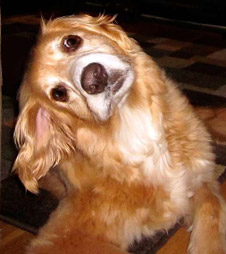Vestibular Disease
The vestibular system includes the parts of the inner ear and brain that help control balance and eye movements. Sensory information from the vestibular system tells a dog or cat is they are upside down, right side up, falling or accelerating.
There are 2 kinds of this disease. Peripheral vestibular disease which is the more common type, and central vestibular disease. The peripheral form arises from outside the central nervous system which is caused by disorders affecting the inner ear. The central vestibular disease, which is more serious, originates inside the central nervous system.
Peripheral vestibular disease can look and feel frightening to the dog owner, especially the first time it occurs. But fortunately, most cases improve quickly with supportive care and treatment, and of course addressing any underlying cause for the condition.
Signs and Symptoms
Signs of vestibular disease can include:
- circling (spinning or walking in circles)
- head tilting
- head shaking
- falling or rolling to one side
- nystagmus (involuntary, rhythmic, jerking eye movements from side to side or up and down)
- stumbling, loss of coordination
- vomiting
- motion sickness
- standing with an exaggerated wide stance
Dizziness and loss of balance can cause excessive drooling, nausea and vomiting. If the disease affects only one ear, head tilting and circling will be in the direction of the affected ear. If only one side of the head is involved, only the eye on that side may develop nystagmus.
Vestibular disease in older dogs is often mistaken for stroke. The vertigo caused by the disease can be particularly intense with symptoms of nausea, difficulty or complete inability to stand up, head tilt, nystagmus, and circling. These can make eating and drinking or even going outside to pee and poop very difficult or even impossible.
Causes of vestibular disease
Peripheral vestibular disease results from damage or infection to the nerves of the inner ear. This can be caused by trauma from head injury, stroke, tumors, polyps, hypothyroidism, as well as certain drugs and even by over-cleaning of the ears resulting in a perforated eardrum.
The disease can be present from birth as a congenital defect. It can also be idiopathic, meaning no specific known cause. An infection of the middle ear is by far the most common reason the disease occurs in younger dogs. In older dogs, conditions such as brain tumor should be ruled out as a potential cause of the syndrome.
Causes of central vestibular disease include inflammatory disease, infection, trauma or bleeding in the brain, loss of blood flow, and cancer.
What sort of treatment and how can I help my pet?
The sudden onset of symptoms is very frightening to owners, often resulting in an understandable sense of urgency. However, idiopathic vestibular disease is not life threatening. Most pets with good general health will naturally adapt and compensate such that the symptoms begin to improve within about 3-4 days and almost completely resolve in 2 weeks, although a head tilt may remain especially in geriatric dogs.
Pets with nausea and vomiting can be treated with motion sickness medications
Dizziness can prevent a dog from walking normally or even not walking at all. Therefore, food and water need to be close by or even brought to them to encourage eating or drinking. Some may even need to be hand-fed until they’re feeling better
Comfort your pet by managing your own stress. Pets are very sensitive to the mood of their companions. So the calmer you are about your pet’s illness, the calmer he/she will be. Think positive energy!
Provide a quiet resting area away from the bustling activities of the household. For example, place your pet in a corner away from human traffic, and loud sounds from talking or the television.
Many pets require assistance in getting to and from their potty spot. But, try to avoid carrying your pet. Your pet needs to retrain his system by navigating on his own. The touch sensors in your pet’s paws provide useful sensory information about balance when he walks. (it does not help if you are carrying him and his paws are dangling in the air). Instead, help him walk on his own by placing your hands on both sides of his body.
Supportive therapy is often needed in the form of supplemental nutrition. Many dogs get really stressed by episodes of vestibular disorder, so natural herbs such as passionflower, skullcap, valerian, and chamomile can be given to senior pets to help them cope. Massage is also a good therapy to calm anxiety and promote recovery.
With a proper diagnosis, the safety of your home, and especially your loving care, your pet’s conditions can often resolve completely.
Paws Fur Life, canine massage & nutrition. A healthy dog is a happy dog



